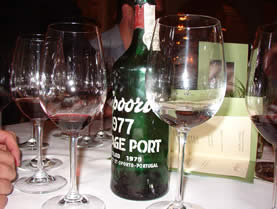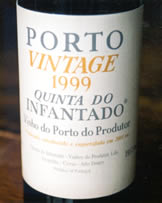|
Sweet
wines: an introduction to these unfashionable gems
 Sadly
sweet wines have had bad PR over recent decades, and it’s now seen
as a social faux pas in many circles to admit to liking your wine in
anything other than a bone dry style. So sweet wines get a raw deal,
relegated to the end of meals accompanying dessert, or forgotten
altogether. But they’re worth discovering in their own right, and
represent some of the wine world’s most interesting, exciting and
down-right tasty gems. And they are not just for maiden aunts or
portly academics, either. Here’s my personal guide to some of the
sweet wines that are worth checking out. Sadly
sweet wines have had bad PR over recent decades, and it’s now seen
as a social faux pas in many circles to admit to liking your wine in
anything other than a bone dry style. So sweet wines get a raw deal,
relegated to the end of meals accompanying dessert, or forgotten
altogether. But they’re worth discovering in their own right, and
represent some of the wine world’s most interesting, exciting and
down-right tasty gems. And they are not just for maiden aunts or
portly academics, either. Here’s my personal guide to some of the
sweet wines that are worth checking out.
Let’s
begin with Port, possibly the world’s most famous sweet wine.
Hailing from the spectacular Douro valley in Portugal, it’s made by
stopping the fermentation of red wine part way through by the addition
of brandy, thus retaining some natural sweetness from the grapes. This
spirit addition also raises the alcohol to around 20%, which helps
preserve the wine against microbial contamination (hence the term
‘fortified’).
 There
are a confusing number of Port styles and categories. It’s probably
best to avoid Ruby and Vintage Character, the cheapest styles. A step
up the quality ladder is Late Bottled Vintage (LBV): of these, I’d
recommend looking for wines labelled ‘traditional’ or
‘crusted’ LBVs, because these wines often give the character of
true Vintage Port at a fraction of the price. At the top of the tree
is Vintage Port, the top wines from particularly good vintages bottled
after just a couple of years in cask. These need long ageing (although
some people quite like them young) and will throw a thick deposit in
the bottle, so need decanting. As a slightly cheaper alternative,
Single Quinta Ports are wines from individual estates that are made in
years that haven’t been declared as vintage. They can often be just
as good, and also require decanting. Leading producers include Taylor,
Fonseca, Niepoort, Warre, Dow, Graham, Noval and Churchill. There
are a confusing number of Port styles and categories. It’s probably
best to avoid Ruby and Vintage Character, the cheapest styles. A step
up the quality ladder is Late Bottled Vintage (LBV): of these, I’d
recommend looking for wines labelled ‘traditional’ or
‘crusted’ LBVs, because these wines often give the character of
true Vintage Port at a fraction of the price. At the top of the tree
is Vintage Port, the top wines from particularly good vintages bottled
after just a couple of years in cask. These need long ageing (although
some people quite like them young) and will throw a thick deposit in
the bottle, so need decanting. As a slightly cheaper alternative,
Single Quinta Ports are wines from individual estates that are made in
years that haven’t been declared as vintage. They can often be just
as good, and also require decanting. Leading producers include Taylor,
Fonseca, Niepoort, Warre, Dow, Graham, Noval and Churchill.
In
a different style, Tawny ports are those that have been aged for a
long time in wood. With age they attain a mellow nutty, spicy
character: particularly worth seeking out are the 10 year old and 20
year old tawnies, and also the Colheitas (vintage dated Tawny wines
that are particularly popular in Portugal). As a general rule, the
longer they spend in wood, the lighter in colour they become and the
more mellow and complex the resulting wine. Port is the classic after
dinner drink, when it typically comes out with the cheese course, but
it’s also something that can be drunk alone any time.
Staying
in the Iberian peninsula but switching countries to Spain, Sherry is
another fortified wine style that’s worth getting to know. Most top
sherries are dry, but there are a few sweet styles worth
investigating. Sherries labelled Pedro Ximenez, made from air-dried
grapes, are extremely sweet and viscous with flavours of liquidized
raisins. These remarkable, unctuous wines are incredible, but won’t
be to everyone’s taste. They work well poured over ice cream.
Hidalgo, Valdespino and Gonzalez Byas make really good examples. Other
seriously tasty sweet sherries include Gonzalez Byas’ Matusalem and
Lustau’s Old East India. The great thing about sherry is that it is
undervalued, and you usually get a lot more than you pay for.
If
you like these sweet sherry styles, then you’ll probably also like
the famous Rutherglen Muscats from Australia. These are ultra-sweet,
complex raisiny wines that take on a deep brown colour from extended
ageing in casks. They’re lovely, but because they are so rich and
intense you’d probably feel as sick as a pig if you drank a whole
bottle. Perfect with rich fruit cake.
If
you want something sweet but a bit lighter, perhaps suitable for
matching with fruity desserts, then sweet muscats from the south of
France might be the answer. These are usually fresh, grapey, aromatic
wines with a lovely freshness that counteracts the sweetness well.
They’re very affordable, too. Muscat de Baumes de Venise is the most
famous, but Muscat de Frontignan, Muscat de Rivesaltes and Muscat de
St Jean de Minervois are also good.
Botrytis
is the key to the success of many of the world’s most famous sweet
wines. Also known as ‘noble rot’, Botrytis cinerea is a fungus
that under the right conditions attacks already-ripe grapes,
shrivelling them, concentrating the sweetness and acidity. The grapes
end up looking disgusting but they make profound sweet white wines, of
which Sauternes is the most famous example. The resulting wines are
sweet and quite viscous, with complex apricot, honey and spice
flavours and good balancing acidity. If you can’t stretch to good
Sauternes, then the best wines of Saussignac and Monbazillac can offer
the same sorts of flavours. I find these wines show best on their own:
most desserts overwhelm the subtleties that you are paying all your
money for.
Also
relying on botrytis for its complexity but made in a different way is
Hungary’s famous sweet wine, Tokaji. The nobly rotted grapes are
made into a paste that is then added to the base wine, adding
sweetness and flavour. Wines from Tokaji aren’t cheap, but they are
unique with complex honey, marmalade and raisiny flavours, often with
a hint of oxidation.
This
is just a brief introduction to the variety of sweet wine styles.
There are many other worthy wines that have not been mentioned here,
including the great German noble-rotted Riesling Trockenbeerenauslesen,
sweet Loire Chenin Blancs, and the rare Eisweins. My advice? Buy
yourself something sweet and give your tastebuds something they’ve
always wanted.
Back to top
|

